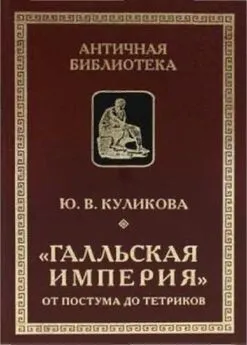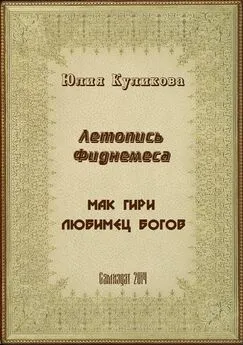Юлия Куликова - «Галльская империя» от Постума до Тетриков
- Название:«Галльская империя» от Постума до Тетриков
- Автор:
- Жанр:
- Издательство:Алетейя
- Год:2012
- Город:Санкт Петербург
- ISBN:978-5-91419-722-0
- Рейтинг:
- Избранное:Добавить в избранное
-
Отзывы:
-
Ваша оценка:
Юлия Куликова - «Галльская империя» от Постума до Тетриков краткое содержание
Опираясь на широкий круг источников и исследований, автор анализирует причины создания «Галльской империи», политический статус этого образования, её территориальный состав, решает проблемы хронологии, выявляет основные направления внутренней и внешней политики галльских императоров. Особое внимание уделено правлению первого галльского императора Постума, обстоятельствам, способствовавшим его приходу к власти, армии и регионам, присягнувшим ему. Проводимая Постумом активная внутренняя и внешняя политика, способствовала преодолению кризисных явлений и стабилизацию положения в регионах, вошедших в состав «Галльской империи».
«Галльская империя» от Постума до Тетриков - читать онлайн бесплатно полную версию (весь текст целиком)
Интервал:
Закладка:
Weisgerber L. J. Rhenania GermanoCeltica. Gesammelte Abhandlungen. Bonn; 1969.
Werner J. Bemerkungen zur mitteldeutschen Skelettgrabergruppe. HasslebenLeuna zur Herkunf der ingentia auxilia Germanorum des gallischen somderreiches in den jahren 259–274 // Festschrift fur W.Schlesinger. Koln.Wien; 1973. — Bd. 1. S. 28–30.
Whittaker C. R. Trade and frontiers of the Roman Empire // Garnsey P.; Whittaker C. Trade and Famine in Classical Antiquity. Cambridge; 1983. P. 110–127.
Wightman E. The fate of GalloRoman viIIIages in the third century // The Roman West… — Part 1. P. 235–244.
Wightman Е. М. Gallia Belgica. California (Los Angeles), 1985.
Wightman E. M. Pagan Cultes in the Province of Belgica // ANRW. 1975. Bd. 11/18. № 1. S. 542–549.
Wightman E. M. The pattern of rural settlment in Roman Gaul // ANRW. 1975. Bd. II /4. P. 584–657.
Wightman E. M. Peasants and potentates: an investigation of social structure and land tenure in Roman Gaul // American Journal of Ancient History. 1978. № 3. P. 97–128.
Wightman E. M. Roman Trier and the Treveri. L.; 1970.
Wightman E. M. Soldier and civilian in early Roman Gaul // LimesAkten des XI Internationalen Limaskongresses 1976. Budapest; 1977. P. 75–86.
WiII E. Les enceintes du BasEmpire a Bavay // Revue du Nord. 1962. Vol. 44. P. 391–401.
WIIIger H. J. Studien zur chronologie des Galienus und Postumus. Diss. Saarbmcken; 1966.
Wilson D. Roman frontiers of Britain. L.; 1967.
Winter F. Stilzusammenhange in der romischen Skulptur Gallien und des Rheinlandes // BJ. 1926. Bd.131. S. 615.
WuIIIeumier P. Lyon. Metropole des Gaules. Paris; 1953.
Wolff H. Civitas und Colonia Treverorum // HISTORIA. 1977. Bd. 26. P. 204–242.
ActaNum — Acta Numismatica. Societat Catalona cTEstudis Numismatics. Barcelona, Spain.
Aep — LAnnee epigraphique
Amphora — Bulletin du Cercle archeologique Amphora. Braine PAlleud, Belgium.
ANRW — Aufstieg Niedergang der Romischen Welt.
Audin — Audin A., Gyey J., WuIIIeumier R Inscriptions latiner decouvertes a Lyon // REA. 1954. LVI. № 3–4. P. 297–346.
BAR — British archeological reports. Supplementary series. Oxford.
BF — Badische Fundberichte
BHAC — Bonner Historia Augusta Colloquium.
BJ — Bonner Jahrbiicher des rheinischen Landesmuseums in Bonn.
BRGK — Berichte der RomischGermanischen Kommission
BSAM — Bulletin Trimestiel de la Societe Academique des Antiquaires de la Marinie.
BSFN — Bulletin de la societe Frangaise de Numismatique. Cabinet des MedaiIIes de la Bibliotheque Nationale. Paris.
CAH — Cambridge Ancient History.
CahN — Cahiers Numismatiques. Bulletin de la Societe d’Etudes Numismatiques et Archeologiques. Paris.
CENB — Cercle d’Etudes Numismatiques. Bulletin Bruxelles.
CIL–Corpus Inscriptionum Latinarum, ed. Preuss. Berlin, 1893–1936.
CRAI–Comptes Rendus de lAcademie des Inscriptions et Belles Lettres.
CSHB — Corpus Scriptores Historii Byzantinae.
Dessau — Dessau H. Inscriptiones Latinae Selectae. Berlin, 1892–1916.
Dobo — Dobo A. Inscriptiones extra fines Pannoniae daciaeque repertae ad res earundem provinciarum pertinentes. Budapest, 1975.
Duval — Duval P — M. Les Inscriptions antiques de Paris. I Texte. Paris, 1960. (Histoire generale de Paris).
EOS — Commentarii Societatis Philologae Polonorum. Wroclaw Ossolineum.
Esperandieu — Esperandieu E. Inscriptions latines de la Gaule (Narbonnaise). Paris, 1929.
FGH — Fragmentorum Gregoricorum Historicum
Germania — Anzeiger der Rom.Ger. Komission des Deutschen Archaol. Instituts. MainzVonzabern.
Helikon — Helikon Rivista di tradizione cultura classica. Messina Univers. Na
Historia — Revue cThistoire ancienne. Wiesbaden.
HISTORIA — Zeitschrift fur alte Gesschihte. Einzeischriften. Stuttgart.
ILS — Inscriptiones Latinae Selectae
JAK — Jahresberichte aus August und Kaiseraugust. Archaol. BaselLandschaft.
JAS — Journal of Archeological Science.
JRS — Journal of Roman Studies
JS — Journal des Savants
KJ — Kolner Jahrbuch.
Konig — Konig I. Die gallischen usurpatoren von Postumus bis Tetricus. Miinchen, 1981. (Vestigia, Bd. XXXI).
Konig (l) — Konig I. Die Meilensteine der Gallia Narbonensis. Bern, 1970. (itinera Romana, 3).
Latomus — Revue d etudes latines. Bruxelles.
LNV–Litterae Numismaticae. Vindobonenses siehe.
MGH — Monumenta Germanica Historium.
MONG — Mitteilungen der Osterreichischen Numismatischen Gesellscheft. Vienna. Austria.
Monum. Germ. Hist. Auct. Antiquiss (MGHAA)
NAC — Numismatica e Antichita classiche quaderni ticinesi Lugano, Arti graf. GagginiBizzozero.
NC — The Numismatic Chronicle. The Royal Numismatic society. Cambridge Univ. Press. London.
Ncirc. — Numismatic Circular. Spink and son. London.
NNb — Numismatisches Nachrichtenblabt. Organ Verbandes der Deutschen Wunzvereine e.v. Speyor. Germany.
PaulyWissowa — Paulys. Real — Encyclopadie der classischen Altertumswissenschaft / Beg. G. Wissowa, Herausgegeben W. von Kroll. Stuttgart, 1935.
PCA — Proceedings of the Classical Association. MurrayLondon.
The Picus — The Picus. Classical and Medieval Numismatic Society. Ontario, Canada.
RBN — Revue beige de numismatique publiee sous les auspices de la Societe royale de numismatique. Bruxelles.
RevNord — Revue du Nord
RH — Revue Historique. ParisPress Univers.
RIB — Collingwood R. G., Wright R. P. The Roman Inscriptions of Britain: Vol. 1–3. Oxford, 1965.
Riese — Riese A. Das Rheinische Germanien in den antiken Inschriften. Berlin, 1914.
RIN — Rivista Italiana di Numismatica e Scienze Affini. Societa Numismatica Italiana in Milano. Milan.
RN — Revue numismatique. Paris.
REA — Revue des etudes anciennes.
SAN — Journal of Society for Ancient Numismatics. Santa Monica, California. U.S.A.
SFMA — Studien zu Fundmunzen der Antike. Franfurt a. M.
SM — Schweizer Miinzblatter) Gazette Numismatique Suisse. Schweizerische Numismatic Gesellscheft. Bern, Switzerland.
TMon — Tresors monetaires. Paris: Bibliotheque nationale.
Vestigia — Beitrage zur alien Geschichte. Munchen.
Vives — Vives J. Inscriptiones latinas de la Espana romana: Bd. 1–2. Barcelona, 1971–1972.
WuIIIeumier — WuIIIeumier P. Inscriptions latines des Trois Gaules. CNRS. Paris, 1963.
ZfN — Zeitschrift fur numisnatik.
Summery
Creation of the «Gallic Empire» one of debatable; but almost moments of history of the ancient Rome not shined in a domestic historiography. To the middle of III century AD the Roman Empire endured crisis. This crisis is defined in a historiography as the general or system though scientific disputes on its essence don t cease tIII now. The system Principatus more couldn't exist in new realities of that time. The dissatisfaction of different social classes with a policy spent by the Roman emperors and its administration led to fast change of emperors; and; as consequence; to instability of the central power. Political crisis was the deepest and was reflected in all control system of the Roman Empire; mentioning economic; social and spiritual life of empire. Separatism display in the provinces; which steels to proclaim own emperors; became result of this crisis. In these conditions the new governor who wIII answer expectations of various social classes was required and can overcome crisis consequences. The militarized layer of the population has decided to solve independently this problem; proclaiming emperors at own choice. The epoch of soldier's emperors was that period during which period the system Principatus has definitively been destroyed and bases of absolutely other control system — Dominatus were put.
The «Gallic Empire» — the name conditional enough. For fifteen years of the existence geographical borders of this state changed and sometimes it is impossible to establish precisely the fact of an accessory of this or that area; or its relation to Gallic emperors. The term the «Gallic Empire» began to be used in the French and German historiography from the end of XIX century. However there was it not casually. For a basis were the words of Eutropius taken out of context; — «Galliarum… imperium» = «Imperium Galliarum». The sources written by witnesses of events; in our disposal practically are absent. Remained are fragmentary and isolated; the information given by them; it is sometimes insignificant it is small. As important addition serves epigraphic and numismatic; especially finds of last years.
In a historiography there are two points of view on character of the «Gallic Empire». The first group of researchers — A.Alfoldi; M.BouvierAjani; I. Konig, E. M.Shtaerman; believes that in 260–270 ththere was an independent state formation led by the sovereign emperor. The second group is assured that Gallic emperors didn't consider themselves as sovereign governors; and saw itself a part of the Roman Empire (R.MacMallen; T.Kotuk; R Bastien). Last point of view amplifies the theory that the Gallic emperors considered themselves as sovereign Roman lords (J. Drinkwater; I.P. Sergeev).
Coming to power of the first Gallic emperor of Postumus became result of many factors. First of all, the big place in these events is occupied with those legions; the lifted Postumus on power top. Crisis and constant intrusions of the German tribes forced the population of provinces to search for an exit in more radical means; instead of to wait for charity from the Roman emperor. The person of the action, capable to have control over not only controls over armies, but also possessing administrative abilities was necessary to them. Anybody is better than the deputy with whom they existed side by side during long time, didn't approach. date of declaration of Postumus is enough disputable, as well as duration of its board. However the find new numismatic sources allow asserting that the Gallic emperor correcting during 15 years has been proclaimed in the winter 258–259 th.
The Postumus internal policy has been directed on stabilization of position in the regions which were a part the «Gallic Empire». Epigraphically finds allow asserting that Postumus was sworn by Gallia, the both Germany, Britain, Spain, Raetia, and also under its control there was a coast of Flanders. As the right during this period operated post factum the «Gallic Empire» de facto represented independent the states, and de jure — its founder in every possible way underlined communication with Rome. It, and also the subsequent actions of Postumus allow asserting that it didn't have claims for the power in the Roman Empire. Existence of protected buffer zones — one more acknowledgement told. The Postumus merit consists that it promoted development of regions, having isolated them from Rome and having neutralized thereby negative consequences crisis. Having strengthened defensibility limes and region as a whole, Postumus has provided safety of the «Gallic Empire». From the moment of formation of the «Gallic Empire» The Gallic emperors along with the state transformations, carried out active financial to the policy. For economic situation stabilization in the new state it was especially important to adjust financial affairs. The coin should get weight in the market thereby to give the chance to the «Gallic Empire» to fasten commercial relations and to restore domestic trade circulation. As separate regions entered under jurisdiction of the new emperor, mints were defined also. The first Gallic emperor minted the coins on official mints of Lugdunum, Narbo, Augusta Treverorum, Colonia Agrippinensium, and from the middle of 60 th— Mediolanum.
Читать дальшеИнтервал:
Закладка:


![Юлия Пульс - Империя Инфернум [publisher: SelfPub]](/books/1074052/yuliya-puls-imperiya-infernum-publisher-selfpub.webp)





